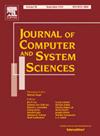破坏最密集的子图是困难的
IF 0.9
3区 计算机科学
Q1 BUSINESS, FINANCE
引用次数: 0
摘要
我们分析了以下计算问题的计算复杂性,称为有界密度边删除和有界密度顶点删除:给定一个图G,一个预算k和一个目标密度τρ,是否有k个边(k个顶点)从G中移除,结果是图中最密集的子图的密度最大τρ?这里,图的密度是它的边数除以顶点数。我们证明了这两个问题在树和团上是多项式时间可解的,而在平面二部图和分裂图上是np完全的。从参数化的角度来看,我们证明了这两个问题就顶点覆盖数而言是固定参数可处理的,但就解的大小而言是W[1]-难处理的。此外,我们证明了有界密度边删除相对于反馈边数是W[1]-困难的,表明该问题在非常稀疏的图上仍然困难。本文章由计算机程序翻译,如有差异,请以英文原文为准。
Destroying densest subgraphs is hard
We analyze the computational complexity of the following computational problems called Bounded-Density Edge Deletion and Bounded-Density Vertex Deletion: Given a graph G, a budget k and a target density , are there k edges (k vertices) whose removal from G results in a graph where the densest subgraph has density at most ? Here, the density of a graph is the number of its edges divided by the number of its vertices. We prove that both problems are polynomial-time solvable on trees and cliques but are NP-complete on planar bipartite graphs and split graphs. From a parameterized point of view, we show that both problems are fixed-parameter tractable with respect to the vertex cover number but W[1]-hard with respect to the solution size. Furthermore, we prove that Bounded-Density Edge Deletion is W[1]-hard with respect to the feedback edge number, demonstrating that the problem remains hard on very sparse graphs.
求助全文
通过发布文献求助,成功后即可免费获取论文全文。
去求助
来源期刊

Journal of Computer and System Sciences
工程技术-计算机:理论方法
CiteScore
3.70
自引率
0.00%
发文量
58
审稿时长
68 days
期刊介绍:
The Journal of Computer and System Sciences publishes original research papers in computer science and related subjects in system science, with attention to the relevant mathematical theory. Applications-oriented papers may also be accepted and they are expected to contain deep analytic evaluation of the proposed solutions.
Research areas include traditional subjects such as:
• Theory of algorithms and computability
• Formal languages
• Automata theory
Contemporary subjects such as:
• Complexity theory
• Algorithmic Complexity
• Parallel & distributed computing
• Computer networks
• Neural networks
• Computational learning theory
• Database theory & practice
• Computer modeling of complex systems
• Security and Privacy.
 求助内容:
求助内容: 应助结果提醒方式:
应助结果提醒方式:


